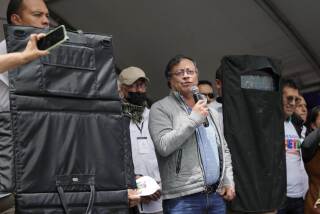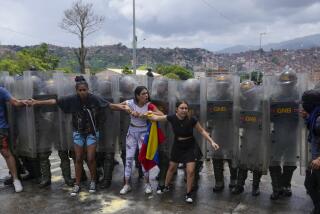NEWS ANALYSIS : Sandinistas Pull Levers of State Power to Woo Votes
- Share via
MANAGUA, Nicaragua — When the National Opposition Union closed its electoral campaign here last weekend, hundreds of Managua-bound supporters were stranded in the city of Masaya. The state-owned trains they were awaiting had been diverted without warning to Leon, scene of that day’s rally of the ruling Sandinista Party.
Nor did the huge sound system rented for the opposition gathering get to Managua. Trucked from Costa Rica, it remained impounded at the border for a fourth straight day, awaiting clearance by Sandinista customs officials.
In an all-out drive for reelection, President Daniel Ortega’s Sandinista government has pulled countless levers of state power to overwhelm its challengers in every way a campaign can be conducted--from fund-raising to media exposure to crowd turnout.
But, in a country torn by guerrilla war and lacking a tradition of free elections, the contentious six-month campaign for Sunday’s election has surprised international observers and opposition parties by its relatively peaceful and open atmosphere.
The Sandinistas flexed their organizational muscle by mobilizing 200,000 to 300,000 supporters in buses, jeeps, dump trucks, trains and army vehicles to a festive demonstration along Managua’s lake front Wednesday. The flow of humanity paralyzed the city of 1 million and made the ruling party’s final rally at least five times bigger than the one staged by the opposition last Sunday.
“They say that the people are mobilized because we pay them or threaten them,” Ortega told the crowd, which was also treated to fireworks, go-go dancers and brass bands. “Those who assert this have received millions of dollars from the North American government, which has not succeeded in buying the conscience of our people.”
By law, politicking was prohibited after midnight Wednesday. And, under a directive by the government’s Supreme Electoral Council aimed at preventing violence, all parties are to keep demonstrators off the streets until midnight Sunday, six hours after the polls close.
The campaign has been marked by hundreds of peaceful rallies drawing large and enthusiastic crowds, mostly for Ortega and Violeta Barrios de Chamorro, presidential candidate of the U.S.-backed opposition union known as UNO. Just one was marred by violence, a Dec. 10 clash between UNO and Sandinista militants that left one man dead at a UNO rally in Masatepe.
Some leaders of the 14-party coalition have complained of a “silent campaign” of Sandinista intimidation against their candidates and poll-watchers. Chamorro’s chief strategist, Alfredo Cesar, charged Wednesday that the Sandinistas have abused their control of the media, public transport and the state bureaucracy to wage a “tremendously unfair campaign.”
Such grievances have been echoed by the Bush Administration throughout the campaign as a basis for questioning whether free and fair elections are possible here.
While reporting extensively on these complaints, both official observer missions, from the United Nations and the Organization of American States, have presented a more favorable picture of the campaign.
“The difficulties that have arisen for the most part have been overcome,” the OAS secretary general, Joao Baena Soares, concluded in a pre-election report issued Wednesday. “It is expected that the elections will take place in a climate that permits citizens to choose freely.”
All assessments of the campaign agree that the Sandinistas, who fought their way to power a decade ago and turned their guerrilla army into a powerful political machine, hold the incumbent’s edge over a fragile and emerging opposition. But several disparities raise the question of fairness:
-- News broadcasts on the state television monopoly gave far more time to Ortega than his challengers. The state-owned Voice of Nicaragua radio network stretched the limits of objectivity by offering prizes such as cars and houses to listeners who correctly predict Ortega’s margin of victory. Under criticism from observer groups, the government expanded free TV time set aside for debate among candidates. Baena Soares’ report said television news coverage was more balanced at the end of the campaign but still gave the Sandinistas more time.
-- Army trucks and other state-owned vehicles were routinely used to transport people to Ortega rallies, while government buildings were festooned with red and black Sandinista banners and wall paintings, in violation of the electoral law.
“They fly the Sandinista flag from an army barracks near my office,” said Guillermo Selva, an opposition member of the electoral council that is assigned to enforce the law. “I asked the army 20 times to remove it, but they just ignored me.”
Baena Soares said the government had shrugged off such appeals, even those made formally by the council. Nor has the government produced the receipts to back its claim that the Sandinista Party rents its trucks from the government.
Even so, he said in an interview, “the use of public facilities (by the government party) happens to some degree in every country. It’s not a threat to this election.”
-- The Sandinistas outspent the opposition while delaying delivery, through the Central Bank, of $3.3 million voted by the U.S. Congress to help Chamorro offset the Sandinistas’ advantages. Those funds reached her coalition in late January, more than a month after they were deposited here--a delay caused, in part, by UNO’s failure to legally register an institute receiving part of the money.
While the $3.3 million made up the bulk of UNO’s campaign budget, the Sandinistas reported spending $6.4 million, including $3 million in materials and $419,000 in cash donated from sympathizers abroad and the rest in corporate and individual contributions at home. UNO’s estimate of Sandinista expenses runs up to $12 million.
Mariano Fiallos, president of the electoral council, noted that UNO fared relatively well compared to the other eight opposition parties, none of which received more than $250,000.
-- Sixty-eight candidates for the National Assembly and 243 candidates for municipal councils resigned during the campaign. Most represented UNO, which claimed they were threatened by state security police and other Sandinista militants with loss of their lives, jobs or property.
Baena Soares endorsed the finding of an earlier U.N. investigation that such cases did not suggest a pattern of intimidation centrally planned by the Sandinista government but rather were the work of local party members. He said his investigation was hampered by the failure of opposition parties to offer evidence of intimidation in most of the cases.
“It’s fair to say that there is a wide discrepancy between the prevalence of these charges and the production of any evidence of such actual intimidation,” said former U.S. Atty. Gen. Elliot Richardson, head of the U.N. mission watching the elections.
Noting that U.S.-backed Contras have attacked and killed at least four Sandinista campaign workers, Baena Soares branded the rebels as “the principal form of electoral violence.”
Despite claims that its poll watchers were threatened, UNO reported this week that it had fielded poll watchers for all but seven of the nation’s 4,391 polling stations, a critical step in monitoring the vote.
Some observer groups are more critical than the U.N. and OAS missions of the Sandinistas’ campaign conduct. But all observers agree that the election itself will have enough safeguards and international scrutiny to ensure a relatively fair count.
“I do not feel the campaign has gone well,” said Allen Weinstein, head of the Washington-based Center for Democracy observer group. “But if I felt the campaign were so badly flawed that it wouldn’t matter what happened on election day, I’d strike my tent and go home.”
Opposition parties have reached the same conclusion. Because the main U.S.- backed anti-Sandinista coalition spoiled the 1984 election by pulling out, it is a notable event in Nicaragua’s violent history that the contending forces are staying in this time.
More to Read
Sign up for Essential California
The most important California stories and recommendations in your inbox every morning.
You may occasionally receive promotional content from the Los Angeles Times.









